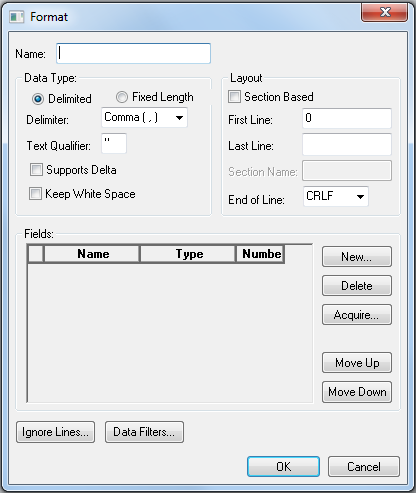Once a text file has been selected, the format of the source file needs to be defined. The basic file structure also needs to be established. Text files will either be fixed width or delimited.
| Fixed Width files | reserve a set amount of spaces for each field (or column) in the data file. Channel will divide the fields according to the widths you nominate. |
| Delimited files | separate (or delimit) each field with a keyboard character such as a comma, tab or quotation marks. Channel will divide the fields according to the delimiter you nominate. |
Click the View button to view the data in the selected file to check if it is fixed width or delimited.
Start defining the input format.
- Choose Input Format
- From the Format Selection dialog box either select an existing entry or create a New format.
| New | Creates a new (blank) format that you can then populate or acquire the settings for |
| Edit | Modify the currently selected format |
| Add | Similar to an import, this function allows you to bring format files from another copy of Channel for you to use. When you click this button Channel will display the File Open dialog box – this will allow you to select the file you want to use. Channel will then copy this file to your Formats directory and add it to your list of available formats |
| Delete | Allows you to remove the currently selected format or formats |
| Copy | Makes a copy of the currently selected format, and opens it for editing – by default it will be called “Copy of format” |
In the Format dialog box which appears (shown below), select and enter the appropriate options.
- In the Name field, enter a appropriate name for the format.
- From the Data Type options, nominate whether the file is Fixed Width or Delimited.
- If you select Delimited you must also select Delimiter and Text Qualifier.
| Delimiter | specifies the character that separates the fields in the data file. You can select from the preset choices from the Delimiter dropdown, or enter your own into the box. |
| Text Qualifier | specifies the character used to mark sections of a field that contain text. For example, if you were creating a comma delimited output file, yet some fields contained commas within the text, selecting “ as the text qualifier would place quotations around text with commas. This is useful when creating comma delimited files for import. |
- Supports Delta is an option primarily designed for use with imports from other Cubix models. Essentially it means that the name of a member is not repeated in a field until it actually changes in the file.
- Keep White Space is an option to allow text fields that have spaces or tabs in them to keep the spaces or tabs. Usually when working with identifiers it is not necessary to have this on. There may be situations where some pre-processing is required and fields need to be joined, or split, thus needing this option on.
The Layout area holds several options.
- Select whether the data file is section based (does the data reside in a separately named section of the file?) or if the data is only one section of the file. Depending on whether this checkbox is on or off, different options will be available.
Section based If you select section based layout, enter the name of the section that contains the data in the box provided. This option is provided mainly for use with exports from other Cubix models.The DATA section of the export file can be specified for processing, avoiding the sections reserved for status information and so on. Non-section based If your input file contains a section that contains the data you are interested in, and you know the line number that this data starts and ends on, you can specify these line numbers and Channel will only use the data in this section of the file. By default, the first line value is 0, and last line is blank – this will include everything in the file. If you want the whole file, you can ignore this option.
- End of Line allows you to nominate what sort of character marks the end of a line. The Windows system uses and carriage return (CR) and a Line Feed (LF) characters. UNIX systems, in contrast, use only the carriage return.
- The Fields area lists the fields in the data file, the data type each field contains, its width and so on. The options available here depend on whether Fixed Width or Delimited was chosen.
- New creates a new field to be included in the import format.
- Delete removes a field from the list. The input format will only read data columns or fields of the source file that are listed in the Fields list.
- The Acquire command allows for a simple and efficient manner to automatically define the individual fields in the data file.
- Ignore Lines allows you to tell Channel which lines contain irrelevant or useless data. Ignored lines may begin with or contain specific characters, or they may be blank.
- Data Filters allow you to process the data in the input fields according to text and rules that you can specify.




Post your comment on this topic.